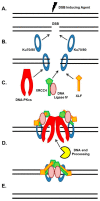The Role of the Core Non-Homologous End Joining Factors in Carcinogenesis and Cancer
- PMID: 28684677
- PMCID: PMC5532617
- DOI: 10.3390/cancers9070081
The Role of the Core Non-Homologous End Joining Factors in Carcinogenesis and Cancer
Abstract
DNA double-strand breaks (DSBs) are deleterious DNA lesions that if left unrepaired or are misrepaired, potentially result in chromosomal aberrations, known drivers of carcinogenesis. Pathways that direct the repair of DSBs are traditionally believed to be guardians of the genome as they protect cells from genomic instability. The prominent DSB repair pathway in human cells is the non-homologous end joining (NHEJ) pathway, which mediates template-independent re-ligation of the broken DNA molecule and is active in all phases of the cell cycle. Its role as a guardian of the genome is supported by the fact that defects in NHEJ lead to increased sensitivity to agents that induce DSBs and an increased frequency of chromosomal aberrations. Conversely, evidence from tumors and tumor cell lines has emerged that NHEJ also promotes chromosomal aberrations and genomic instability, particularly in cells that have a defect in one of the other DSB repair pathways. Collectively, the data present a conundrum: how can a single pathway both suppress and promote carcinogenesis? In this review, we will examine NHEJ's role as both a guardian and a disruptor of the genome and explain how underlying genetic context not only dictates whether NHEJ promotes or suppresses carcinogenesis, but also how it alters the response of tumors to conventional therapeutics.
Keywords: DSB repair; NHEJ; cancer; cancer therapy; carcinogenesis; genomic instability.
Conflict of interest statement
The authors declare no conflict of interest.
Figures


Similar articles
-
Mechanisms of DNA double strand break repair and chromosome aberration formation.Cytogenet Genome Res. 2004;104(1-4):14-20. doi: 10.1159/000077461. Cytogenet Genome Res. 2004. PMID: 15162010 Review.
-
Induction and repair of DNA double strand breaks: the increasing spectrum of non-homologous end joining pathways.Mutat Res. 2011 Jun 3;711(1-2):61-72. doi: 10.1016/j.mrfmmm.2011.02.005. Epub 2011 Feb 15. Mutat Res. 2011. PMID: 21329706 Review.
-
DNA double strand breaks (DSB) and non-homologous end joining (NHEJ) pathways in human leukemia.Cancer Lett. 2003 Apr 10;193(1):1-9. doi: 10.1016/s0304-3835(02)00692-4. Cancer Lett. 2003. PMID: 12691817 Review.
-
The role of nonhomologous DNA end joining, conservative homologous recombination, and single-strand annealing in the cell cycle-dependent repair of DNA double-strand breaks induced by H(2)O(2) in mammalian cells.Radiat Res. 2008 Dec;170(6):784-93. doi: 10.1667/RR1375.1. Radiat Res. 2008. PMID: 19138034
-
Examining DNA Double-Strand Break Repair in a Cell Cycle-Dependent Manner.Methods Enzymol. 2017;591:97-118. doi: 10.1016/bs.mie.2017.03.012. Epub 2017 Apr 17. Methods Enzymol. 2017. PMID: 28645381 Free PMC article.
Cited by
-
Inhibition of DNA Repair in Cancer Therapy: Toward a Multi-Target Approach.Int J Mol Sci. 2020 Sep 12;21(18):6684. doi: 10.3390/ijms21186684. Int J Mol Sci. 2020. PMID: 32932697 Free PMC article. Review.
-
Dynamics of Gut Microbiota and Clinical Variables after Ketogenic and Mediterranean Diets in Drug-Naïve Patients with Type 2 Diabetes Mellitus and Obesity.Metabolites. 2022 Nov 10;12(11):1092. doi: 10.3390/metabo12111092. Metabolites. 2022. PMID: 36355175 Free PMC article.
-
DNA Damage and Its Role in Cancer Therapeutics.Int J Mol Sci. 2023 Mar 1;24(5):4741. doi: 10.3390/ijms24054741. Int J Mol Sci. 2023. PMID: 36902170 Free PMC article. Review.
-
Microsatellite instability states serve as predictive biomarkers for tumors chemotherapy sensitivity.iScience. 2023 Jun 7;26(7):107045. doi: 10.1016/j.isci.2023.107045. eCollection 2023 Jul 21. iScience. 2023. PMID: 37448561 Free PMC article.
-
Residual Foci of DNA Damage Response Proteins in Relation to Cellular Senescence and Autophagy in X-Ray Irradiated Fibroblasts.Cells. 2023 Apr 21;12(8):1209. doi: 10.3390/cells12081209. Cells. 2023. PMID: 37190118 Free PMC article.
References
Publication types
Grants and funding
LinkOut - more resources
Full Text Sources
Other Literature Sources

